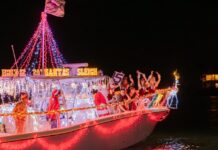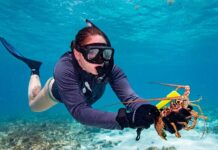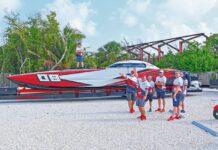
A rescued juvenile male bottlenose dolphin, flown from Texas to the Marathon-based Dolphin Research Center seven weeks ago, was successfully moved to the facility’s primary dolphin lagoon May 12 — a move that marks his final integration into a “forever family” of other permanent dolphin residents.
“Ranger” has convalesced and been monitored over the last several weeks in a specially designed medical quarantine pool to increase his eating and weight while he strengthens both his immune system and his bond with human caregivers.

He was rescued nearly a year ago after being discovered stranded in waters around Goose Island State Park in Texas, suffering from an underlying respiratory infection and dehydration following his mother’s death.
To maneuver Ranger safely from quarantine, DRC staff employed a specially designed marine mammal stretcher and carefully placed him into the natural Florida Bay water of the facility’s main lagoon. Dolphins in surrounding pools observed as Ranger speedily explored his spacious new home, taking in their neighboring sonar signals for the first time since arriving at the rehabilitation facility in late March.

It only took 45 minutes for Ranger to begin interacting and taking food from Linda Erb, DRC’s vice president of animal care and training.
“We were pretty surprised that he decided to turn on and eat within probably 30, 45 minutes of getting in the pool,” Erb said. “You can imagine he hasn’t heard dolphin sounds for over a year.
“He’s inundated,” she added. “There are dolphins all around him. He’s looking at them. I thought the last thing he was gonna be interested in was fish.”

According to DRC’s staff and trainers, an important outcome of Ranger’s final move Thursday was to ensure he would eat freely, critical to his full adjustment to the new surroundings.
An initial assessment of the orphaned calf indicated that at the time of his rescue, at just two years old, he lacked the skills necessary to forage and survive in the wild. The National Marine Fisheries Service then selected the Keys’ uniquely experienced DRC facility as a permanent home. Ranger now weighs a healthy 235 pounds.

Ranger’s relocation to the Florida Keys, as well as his continued treatment at the nonprofit DRC, was made possible by donations from worldwide and national communities and mammal rescue networks, including a special JET ICU air ambulance service that flew him from Texas direct to Marathon.






















